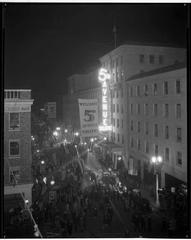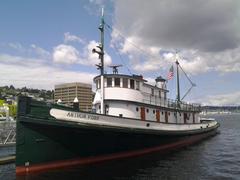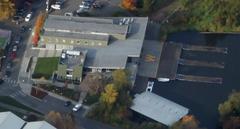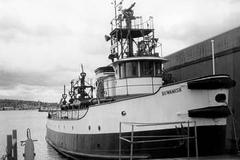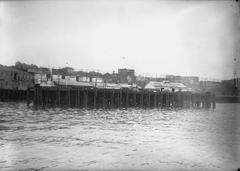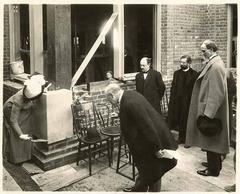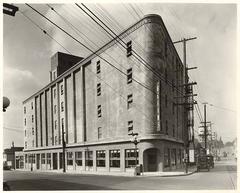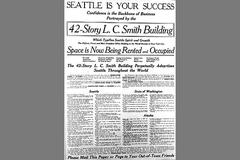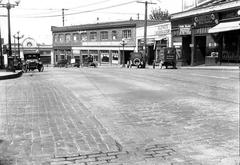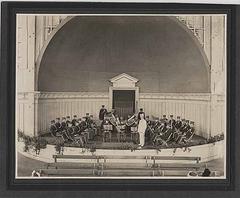
Camlin Hotel Seattle: Visiting Hours, Tickets, and Historical Significance
Date: 04/07/2025
Introduction
Located in the vibrant heart of downtown Seattle, the Camlin Hotel stands as one of the city’s most storied landmarks. With nearly a century of architectural distinction and cultural significance, the Camlin encapsulates Seattle’s urban development, from its origins in the Roaring Twenties to its current status as a private resort within the WorldMark vacation club network. Designed by Carl L. Linde to evoke the grandeur of an Italian castle, the Camlin’s terra-cotta façade, iconic neon signage, and proximity to major attractions like the Paramount Theatre continue to draw history enthusiasts, photographers, and travelers alike (PCAD; Kiddle).
Although public access to the hotel’s interior is now limited, the Camlin’s preserved exterior and historic legacy offer visitors a unique opportunity to connect with Seattle’s past. This guide provides an in-depth look at the hotel’s history, architectural highlights, practical tips for visitors, and the broader context of its cultural legacy.
Table of Contents
- Historical Overview
- Visiting the Camlin Hotel Today
- Frequently Asked Questions
- Conclusion
- References
Historical Overview
Origins and Architectural Vision (1924–1926)
The Camlin Hotel, originally the Camlin Apartment Hotel, was conceived during Seattle’s 1920s growth boom. Developed by Adolph Linden and Edmund W. Campbell, its construction began in 1924 and concluded in 1926. Carl L. Linde, the architect, imbued the structure with Italianate elegance—red brick with terra-cotta accents and castle-like turrets—making it a visual standout among downtown’s emerging skyline (PCAD; Kiddle). The original building featured 94 apartment units with modern amenities for the era, and a penthouse suite offering panoramic views of Puget Sound and the Olympic Mountains (Kiddle).
Financial Challenges and Ownership Transitions
The Camlin’s launch was shadowed by financial controversy. Linden and Campbell, both executives at Puget Sound Savings & Loan, used significant bank funds for the hotel’s construction. This led to a quiet transfer of ownership to the bank, and eventually, both men were convicted of fraud and served prison sentences (Kiddle; Seattle Times). By the early 1930s, the property was acquired by the Vance Lumber Company, marking the beginning of a series of ownership changes.
The Cloud Room Era (1940s–1960s)
Significant enhancements in the 1940s included the addition of a cocktail lounge and extra guest rooms. In 1947, the penthouse was transformed into the Cloud Room, a celebrated rooftop lounge offering breathtaking city vistas. The Cloud Room quickly became a magnet for celebrities, performers, and socialites, earning national awards and cementing the Camlin’s place in Seattle’s nightlife and cultural history (PCAD; Seattle Times). The hotel’s central location and amenities made it a preferred accommodation for artists and visitors, especially during events like the World’s Fair and the Sky River Rock Festival.
Preservation and Modern Era
In the late 20th century, the Camlin underwent numerous ownership transitions and faced challenges from aging infrastructure and changing market demands (PCAD). Its listing on the National Register of Historic Places in 1999 recognized its enduring architectural and cultural importance (Kiddle). In 2003, Trendwest Resorts acquired the property, investing over $21 million in renovations and converting it into WorldMark Seattle: The Camlin, a timeshare-focused resort. The Cloud Room was closed, and the building now caters exclusively to WorldMark members, though its historic exterior remains a cherished city landmark (WorldMark; Seattle Times).
Visiting the Camlin Hotel Today
Public Access and Visiting Hours
Currently, the Camlin Hotel operates as a private resort for WorldMark vacation club members. Public access to the interior, including guest rooms and former public spaces like the Cloud Room, is restricted. While there are no tickets required or public tours offered, the hotel’s historic exterior can be admired freely from the street at any time. Occasionally, special events may allow limited access—check with the official WorldMark site for updates.
Summary of Access:
- Exterior Viewing: Open 24/7, no ticket required.
- Interior Access: Restricted to registered WorldMark guests.
- Guided Tours: Not offered on a regular basis.
Accessibility and Travel Tips
The Camlin is centrally located at 1619 9th Avenue, easily accessible by public transit, rideshare, or on foot from major downtown attractions. The building and its surrounding sidewalks are ADA-compliant, and nearby venues also offer accessible facilities.
Travel Tips:
- Best Time for Photos: Daytime, for optimal lighting on the terra-cotta façade.
- Parking: Limited street parking; several paid garages nearby.
- Dining: No on-site restaurant, but numerous eateries are within walking distance.
- Accommodation: Suites are reserved for WorldMark members; select rooms allow pets and are family-friendly (Booking.com).
Nearby Attractions
The Camlin’s location places it in proximity to several of Seattle’s top historical and cultural sites:
- Paramount Theatre: Renowned for live performances and historic architecture.
- Washington State Convention Center: Major events and exhibitions.
- Pike Place Market: Iconic marketplace for local food and crafts.
- Seattle Art Museum: Diverse collection of art and rotating exhibitions.
Frequently Asked Questions
Q: Is the Camlin Hotel open to the public?
A: The hotel operates as a private WorldMark resort; only members and their registered guests have access to the interior.
Q: Are there public tours or tickets?
A: No public tours or tickets are available; the property is reserved for members.
Q: Can I visit the Cloud Room?
A: The Cloud Room is permanently closed and not accessible to the public.
Q: Is the hotel pet-friendly?
A: Some suites accommodate pets; check policies when booking as a WorldMark guest.
Q: Is the hotel accessible for visitors with disabilities?
A: Yes, the property is ADA-compliant for registered guests.
Conclusion
The Camlin Hotel remains a distinguished symbol of Seattle’s architectural and cultural evolution. Though its function has shifted to a private resort, its preserved façade, neon signage, and storied past continue to resonate with visitors and locals alike. While interior access is restricted, the Camlin’s exterior and its central location make it an essential stop for those exploring Seattle’s historic core. For an immersive experience, pair a visit to the Camlin with nearby landmarks such as the Paramount Theatre, Pike Place Market, and the Seattle Art Museum.
For further exploration of Seattle’s historical sites, download the Audiala app and browse our related guides and resources.
References and Further Reading
- Camlin Hotel Seattle: History, Visiting Hours, Tickets & Travel Tips (PCAD; Kiddle)
- Camlin Hotel Seattle: Visiting Hours, Tickets, and Historic Charm (Wikipedia; Booking.com)
- Camlin Hotel Seattle: History, Visiting Information, and Cultural Legacy (Seattle Times)
- WorldMark Seattle: The Camlin Official Website (WorldMark)
- Additional sources: Archillects, pauldorpat.com, worldmark-camlin-hotel.washington-state.net, Seattle Times Archive, Audiala




